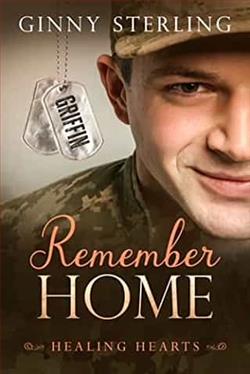Summary

Remember Home
by Ginny Sterling
Dear John…
When Lily Hogan’s fourth-grade class writes letters to the military stationed in Afghanistan, she takes up her own pen, writing to an unknown soldier.
John Griffin and his bomb detection dog, Radar, spend their days in Afghanistan sniffing out explosives, searching the hills for insurgents, and leading his team… until an unexpected letter arrives.
Could a simple correspondence with a perfect stranger bring a fresh start to a life and love John never expected?
.
Read
Remember Home on http://kissnovel.net
Martial Peak Reviews
Remember Home by Ginny Sterling is a poignant exploration of connection, healing, and the unexpected ways in which love can blossom amidst the chaos of war. The narrative centers around Lily Hogan, a bright fourth-grader whose innocent act of writing letters to soldiers stationed in Afghanistan sets off a chain of events that profoundly impacts the lives of both her and John Griffin, a soldier grappling with the harsh realities of his deployment.
The premise of the story is deceptively simple: a child’s letter reaches a soldier, and through their correspondence, both characters embark on a journey of self-discovery and emotional growth. From the outset, Sterling skillfully juxtaposes the innocence of childhood with the grim realities of military life. Lily’s letters are filled with curiosity and warmth, providing a stark contrast to John’s experiences in a war-torn landscape. This contrast serves to highlight the theme of innocence versus experience, a recurring motif throughout the book.
One of the most compelling aspects of Remember Home is the character development of John Griffin. Initially portrayed as a hardened soldier, John’s character is gradually revealed to be layered and complex. His interactions with Lily’s letters allow readers to witness his vulnerability and longing for connection. Sterling does an excellent job of illustrating how the emotional toll of war can lead to isolation, and how a simple act of kindness can rekindle hope. As John begins to respond to Lily, we see him evolve from a man burdened by his experiences to someone who dares to dream of a future beyond the battlefield.
Lily, on the other hand, embodies the purity of youth. Her letters are not just a means of communication; they are a lifeline for John. Through her innocent questions and heartfelt sentiments, she becomes a beacon of light in his dark world. Sterling captures the essence of childhood beautifully, portraying Lily as a character who, despite her young age, possesses a wisdom that transcends her years. The bond that forms between Lily and John is both heartwarming and profound, reminding readers of the power of human connection.
The theme of healing is intricately woven throughout the narrative. Both John and Lily are seeking solace in their own ways—John from the trauma of war, and Lily from her own personal struggles. Their correspondence serves as a therapeutic outlet, allowing them to confront their fears and insecurities. Sterling’s portrayal of this healing process is both realistic and uplifting, emphasizing that recovery is often a gradual journey marked by small victories.
Another significant theme in the book is the concept of home. For John, home is not just a physical place; it is a state of mind that he yearns to reclaim. Through his letters to Lily, he begins to redefine what home means to him, moving beyond the confines of his military life. This exploration of home resonates deeply, especially in a world where many are displaced or searching for belonging. Sterling’s ability to evoke such strong emotions surrounding the idea of home adds depth to the narrative, making it relatable to a wide audience.
The pacing of the story is well-balanced, allowing readers to savor the development of the characters’ relationship without feeling rushed. Sterling’s writing style is engaging and accessible, making it easy for readers to immerse themselves in the world she has created. The letters exchanged between Lily and John are particularly well-crafted, capturing the essence of their personalities and the evolution of their bond. Each letter serves as a stepping stone in their journey, revealing more about their hopes, fears, and dreams.
In terms of emotional impact, Remember Home is a powerful read. Sterling does not shy away from the harsh realities of war, yet she manages to infuse the narrative with hope and resilience. The juxtaposition of the innocence of childhood with the brutality of military life creates a poignant tension that lingers long after the last page is turned. Readers will find themselves reflecting on the nature of love, the importance of connection, and the ways in which we can support one another through difficult times.
When compared to other works that explore similar themes, such as The Things They Carried by Tim O’Brien or Dear John by Nicholas Sparks, Sterling’s approach is unique in its focus on the innocence of childhood as a catalyst for healing. While O’Brien’s work delves into the psychological burdens of war and Sparks’ narrative centers around romantic love, Sterling’s story emphasizes the transformative power of friendship and the unexpected ways in which love can manifest.
In conclusion, Remember Home is a beautifully crafted novel that resonates on multiple levels. Ginny Sterling has created a heartfelt story that explores the complexities of human connection, the journey of healing, and the enduring search for home. Through the eyes of Lily and John, readers are reminded of the profound impact that even the simplest acts of kindness can have on our lives. This book is a must-read for anyone seeking a story that is both touching and thought-provoking, and it will undoubtedly leave a lasting impression on those who turn its pages.
























Reviews 0
Post a Reviews: